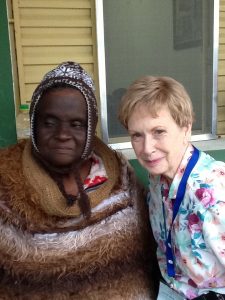In 2011, the National Council of the United States, Society of St. Vincent de Paul made history when Vincentians elected the first woman to serve as their National President. Her name is Sheila Gilbert, and she served in the role from 2011 – 2017.

Prior to being elected president, Gilbert served as the National Secretary on the National Board of Directors, under President Joe Flannigan, and as a committee chair under President Gene Smith.
Volunteerism
Volunteerism courses through her veins. In addition to her work with the Society, Gilbert has also volunteered as a Girl Scout Leader, PTO President, CCD Instructor, and Adult Faith Formation Coordinator at her home parish.
“It seems like when I see something that needs doing, and I think I can do it, I volunteer,” said Gilbert.
Gilbert first became involved with the Society of St. Vincent de Paul when a Conference was formed at her parish. She also volunteered at the parish distribution center.
Path to Leadership
Her path to leadership within the Society began when she served as the President of the Indianapolis North District Council, and the Archdiocesan Council of Indianapolis. She was the Mideast Region Vice President, and Chair of the National Formation Committee.
While also serving in her various leadership roles within the Society, Gilbert also served on the Board for the Vincentian Family Committee and completed two terms representing the Society on the Ladies of Charity‘s National Board. During her time as SVdP President, she was a “participating observer” on the National Catholic Charities Board.
Gilbert’s volunteer work prior to and during her time as the first female SVdP National President was not without its challenges. “As a woman working for the Catholic Church in a local parish, I often felt a bit ‘second class,’ and some gentlemen in the Society had a tendency to pat me on the head, rather than take me seriously, especially early on.”
work prior to and during her time as the first female SVdP National President was not without its challenges. “As a woman working for the Catholic Church in a local parish, I often felt a bit ‘second class,’ and some gentlemen in the Society had a tendency to pat me on the head, rather than take me seriously, especially early on.”
Although she was heartened by the encouragement she received when it came to her campaign for President and once she took the office, Gilbert notes that the challenges she faced were like those of any person coming into office, not specifically because she was a woman.
“I never even thought about them as having to do with being female,” Gilbert said.
Advice for Others
Though her term ended in 2017, Gilbert remains very passionate about the Society and about women’s involvement.
“[My] advice: Follow the guidance your heart receives from the Holy Spirit. Talk with people you respect. Take one step forward at a time and don’t be afraid to try,” said Gilbert. “No one ever has all the skills and abilities for any leadership position, but the Holy Spirit knows how to fill in the gaps. Believe that you can rely on God and other Vincentians.
Gilbert. “No one ever has all the skills and abilities for any leadership position, but the Holy Spirit knows how to fill in the gaps. Believe that you can rely on God and other Vincentians.
“I became National President because others believed in me more than I believed in myself. Every Vincentian can look around and find someone in whom they see potential and provide the support and encouragement that makes their leadership possible and successful.”
When asked about her hopes for females within the Society as time goes on, she said, “I only hope I won’t hold the title of the ONLY female president.”






